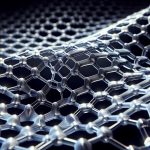Imagine running a marathon and realizing your shirt is not only keeping you cool but also monitoring your essential signs. That's the power of graphene-enhanced fabrics. These innovative materials boast exceptional electrical conductivity and durability, making them a game-changer in sportswear and beyond. You'll find graphene's benefits extending to medical applications where antimicrobial properties and wound healing capabilities are crucial. What's more, their alignment with sustainability goals through reduced resource consumption and recyclability is driving adoption across industries. Curious about how this technology is shaping the future of textiles? There's much more to uncover.
Table of Contents
Key Takeaways
- Graphene fabrics offer unparalleled electrical conductivity, enhancing applications in smart textiles and wearable technology.
- They provide superior durability and comfort, ideal for high-performance sportswear that withstands rigorous use.
- Antimicrobial and wound healing properties make graphene-enhanced fabrics suitable for advanced medical applications.
- Environmental benefits include reduced resource consumption, better insulation, and potential recyclability, contributing to sustainability goals.
- Technological advancements are making graphene fabrics more accessible, driving increased industry demand and applications across various sectors.
Properties of Graphene
Graphene's unique properties make it one of the most remarkable materials ever discovered. If you're looking to understand why, you need to explore its unparalleled electrical conductivity and thermal stability.
Imagine a material that can conduct electricity better than copper. Graphene does just that, enabling faster and more efficient electronic devices. Its single layer of carbon atoms arranged in a hexagonal lattice allows electrons to move freely, minimizing resistance and energy loss.
But electrical conductivity is just the beginning. Graphene also boasts exceptional thermal stability. It can withstand extreme temperatures without degrading, making it ideal for applications requiring high heat tolerance. Think about it: a material that remains stable and effective in conditions where others would falter. This is why graphene is making waves in industries ranging from electronics to aerospace.
When you combine these properties, you see why graphene is so revolutionary. Its ability to conduct electricity efficiently and maintain stability under heat opens doors to innovations previously thought impossible.
Manufacturing Techniques
To understand how graphene-enhanced fabrics are made, you'll need to explore coating and infusion methods, as well as nanocomposite weaving techniques.
These approaches guarantee graphene is effectively integrated into textile materials.
Let's look at how each technique contributes to the final product.
Coating and Infusion Methods
Manufacturing techniques for graphene-enhanced fabrics primarily involve coating and infusion methods that guarantee the material's properties are effectively integrated into textiles.
One popular technique is spray application, where a graphene-based solution is sprayed onto the fabric's surface. This method secures an even distribution of graphene, enhancing the fabric's conductivity and strength. You'll appreciate that spray application offers precision and control, making it ideal for high-performance textiles where uniformity is essential.
Another key method is chemical bonding. Here, graphene is chemically bonded to the fabric fibers, creating a durable and stable integration that withstands wear and tear. Chemical bonding leverages advanced chemistry to secure that the graphene layers adhere tightly to the textile fibers. This method enhances the fabric's durability, thermal regulation, and even its antibacterial properties.
You'll find that chemical bonding is particularly beneficial for applications requiring long-term stability and performance.
Nanocomposite Weaving Techniques
Building on the strengths of coating and infusion methods, nanocomposite weaving techniques offer an innovative approach to integrating graphene into fabrics at the fiber level. With these advanced methods, you can achieve unparalleled fiber reinforcement, ensuring that the graphene is uniformly distributed throughout each thread.
This results in fabrics that aren't only stronger but also more flexible, making them ideal for a variety of high-performance applications.
When you focus on textile integration using nanocomposite weaving, you're not just adding graphene to the surface; you're embedding it within the very structure of the fabric. This deep integration enhances the durability, conductivity, and thermal properties of the material, providing a significant edge over traditional methods.
Additionally, this technique allows for the creation of lightweight fabrics that maintain their structural integrity under stress.
High-Performance Sportswear
High-performance sportswear often benefits from the incredible properties of graphene-enhanced fabrics, offering athletes superior comfort and durability. You'll find that these advanced materials excel in sweat absorption, keeping you dry and comfortable during intense workouts. The graphene's unique structure allows it to efficiently wick away moisture, ensuring you stay focused on your performance rather than being distracted by sweat.
Moreover, the durability and flexibility of graphene-enhanced fabrics make them ideal for high-performance sportswear. These fabrics can withstand the wear and tear of rigorous training sessions while maintaining their shape and elasticity. You won't have to worry about your gear losing its form or becoming less effective over time. The remarkable strength of graphene means your sportswear will remain reliable, no matter how demanding your activities are.
Graphene's lightweight nature also adds to the overall comfort of your sportswear. You'll barely notice the fabric, allowing you to move freely and naturally. This combination of sweat absorption, durability, and flexibility truly sets graphene-enhanced sportswear apart from traditional materials.
For athletes seeking the best in performance and longevity, these fabrics are a game-changer, offering unmatched quality and functionality.
Medical Applications
Graphene-enhanced fabrics aren't just revolutionizing sportswear; they're also making significant strides in medical applications. When it comes to antimicrobial protection, these fabrics are unparalleled. Imagine a hospital environment where the risk of infections from bacteria and viruses is substantially reduced. That's the promise graphene brings. Its unique structure disrupts the cell membranes of microbes, effectively neutralizing them. This means your medical scrubs or wound dressings can actively combat potential infections, offering a safer and more hygienic solution.
Additionally, graphene's wound healing properties are nothing short of remarkable. Traditional wound care can be cumbersome and slow, but integrating graphene into fabrics accelerates the healing process. How, you ask? Graphene's exceptional conductivity promotes cellular regeneration and tissue growth. As a result, wounds heal faster, reducing downtime and improving patient outcomes.
Environmental Benefits
Embracing graphene-boosted fabrics could lessen our environmental footprint. By incorporating graphene, you're investing in eco-friendly production methods that greatly reduce resource consumption.
Graphene's impressive strength allows fabrics to be more durable, meaning they last longer and don't need to be replaced as frequently. This durability directly translates to less waste and fewer resources used over time.
Graphene also enhances fabric performance, enabling efficient thermal regulation. You'll find that these fabrics provide better insulation, which can reduce the need for energy-intensive heating and cooling systems. The sustainability advantages extend beyond mere energy savings; graphene-boosted fabrics often require fewer chemical treatments, which means fewer pollutants and less water usage during manufacturing.
Furthermore, the environmental benefits of graphene-boosted fabrics include their potential for recyclability. When you consider the entire lifecycle of clothing, from production to disposal, using recyclable materials becomes essential. Graphene-infused textiles can be more easily broken down and repurposed, minimizing landfill waste.
Fashion Industry Impact
In the fashion industry, graphene-enhanced fabrics are revolutionizing both design possibilities and sustainability practices. You're now witnessing a paradigm shift where innovation meets eco-consciousness.
Designers are seizing the sustainability advantages of graphene to create garments that aren't only stylish but also environmentally friendly. This cutting-edge material offers unprecedented durability, flexibility, and thermal regulation, making it a favorite in fashion design collaborations.
For consumers, the perception of graphene-enhanced fabrics is overwhelmingly positive. They associate these advanced textiles with high quality and modernity, reinforcing their appeal. Smart marketing strategies are capitalizing on this perception, highlighting not only the stylish aspects but also the sustainable benefits of graphene.
- Innovative Designs: Graphene's unique properties allow for groundbreaking fashion designs that were previously impossible.
- Eco-Friendly Production: Utilizing graphene can notably reduce the environmental impact, aligning with global sustainability goals.
- Enhanced Performance: Garments made with graphene offer superior performance, from improved comfort to increased longevity.
As a fashion enthusiast or professional, you'll find that integrating graphene-enhanced fabrics into your work isn't just a trend but a forward-thinking approach that promises to reshape the industry.
Market Trends
You'll notice the market for graphene-enhanced fabrics is expanding rapidly due to growing industry demand.
Technological advancements are playing a pivotal role in this growth, making these fabrics more accessible and versatile.
Additionally, the competitive landscape is evolving as more companies enter the market, each aiming to innovate and capture consumer interest.
Growing Industry Demand
As the benefits of graphene-enhanced fabrics become more evident, industries across the board are ramping up their demand for these innovative materials. You're witnessing a seismic shift in the supply chain as manufacturers scramble to integrate graphene into their production lines. This surge is driven by consumer preferences leaning towards products that offer superior durability, conductivity, and thermal regulation.
Consider these market trends shaping the landscape:
- Sustainability Focus: Consumers are increasingly eco-conscious, and graphene-enhanced fabrics offer a longer lifespan and reduced environmental impact.
- Performance Apparel: Athletes and outdoor enthusiasts demand high-performance gear, and graphene's properties make it ideal for creating breathable, lightweight, and robust fabrics.
- Healthcare Applications: The medical field is adopting graphene-infused textiles for their antibacterial properties, enhancing the sterility and functionality of wearable medical devices.
You should also note that the growing industry demand isn't just about meeting current consumer needs but also anticipating future trends. Businesses are investing in research and development to stay ahead of the curve. The supply chain must adapt quickly, ensuring that the raw materials for graphene production are accessible and sustainable.
Technological Advancements Impact
Technological advancements in graphene-enhanced fabrics are revolutionizing the market, driving innovation and setting new performance standards. You're witnessing a groundbreaking shift where innovative materials aren't just enhancing the durability and functionality of fabrics but also transforming the textile industry's approach to sustainability.
Graphene's exceptional properties, such as its strength and conductivity, are enabling the creation of fabrics that are lighter, more flexible, and incredibly resilient.
These advancements are pushing sustainability initiatives to the forefront. Companies are now able to produce textiles that not only perform better but also have a reduced environmental impact. For instance, graphene's ability to enhance the efficiency of dyeing processes means less water and fewer chemicals are required, aligning with the global push towards more eco-friendly manufacturing practices.
Moreover, the market trends indicate a growing consumer demand for high-performance, sustainable textiles. As a result, businesses that integrate graphene into their products are gaining a competitive edge. By embracing these innovative materials, you can stay ahead in a market that increasingly values both cutting-edge technology and environmental responsibility.
The impact of these advancements is undeniable, setting a new benchmark for the future of the textile industry.
Competitive Landscape Dynamics
Many companies are vying for position in the graphene-enhanced fabrics market, driven by the growing consumer demand for innovative and sustainable textiles.
You'll find that market competition is fierce, with key players like Directa Plus, Versarien, and Graphenea all pushing to outpace each other through technological advancements and strategic partnerships.
Industry growth is accelerating, fueled by the unique properties of graphene that offer superior durability, thermal regulation, and antimicrobial features.
To master the competitive landscape, focus on these pivotal trends shaping the market:
- Collaborative Ventures: Companies are forming alliances with research institutions and material scientists to stay ahead.
- Product Diversification: Leaders in the market are expanding their portfolios, incorporating graphene into various types of fabrics, from sportswear to medical textiles.
- Sustainability Efforts: There's a strong emphasis on developing eco-friendly production methods to meet regulatory standards and consumer expectations.
Future Prospects
Looking ahead, graphene-boosted fabrics promise to revolutionize the textile industry with their unparalleled strength, conductivity, and versatility. You'll find that the sustainability benefits of these fabrics are remarkable. Graphene's integration can reduce the need for harmful chemicals and lower energy consumption during production. Consequently, this aligns with the growing demand for eco-friendly solutions, driving significant market growth.
As consumers become more eco-conscious, the adoption of graphene-boosted textiles will likely surge, opening new avenues for innovation and expanded market reach.
In terms of innovation opportunities, the possibilities are boundless. Graphene's exceptional properties allow for the creation of highly durable materials that can withstand extreme conditions while maintaining comfort and flexibility. You can envision applications ranging from high-performance sportswear to advanced military gear and even smart textiles that monitor health metrics in real-time.
The material durability of graphene-boosted fabrics ensures longevity, reducing waste and contributing to a more sustainable future.
Frequently Asked Questions
How Do Graphene-Enhanced Fabrics Compare to Traditional Fabrics in Terms of Comfort?
You'll find graphene-enhanced fabrics offer superior breathability and durability compared to traditional fabrics. They regulate temperature better, keeping you comfortable in various conditions while lasting longer, making them a smart investment for any wardrobe.
Are Graphene-Enhanced Fabrics Safe for Individuals With Sensitive Skin?
You'll find graphene-enhanced fabrics generally safe for sensitive skin. They're designed to minimize skin irritation and allergies while offering impressive fabric breathability and softness. Always check for certified products to guarantee the highest quality standards.
Can Graphene-Enhanced Fabrics Be Dyed or Customized With Patterns?
You can definitely explore dyeing options with graphene-enhanced fabrics. They offer excellent pattern customization possibilities, allowing you to create unique designs. This flexibility guarantees you achieve the desired aesthetic while maintaining the fabric's advanced properties.
What Are the Washing and Care Instructions for Graphene-Enhanced Fabrics?
For fabric longevity, wash graphene-enhanced fabrics in cold water with mild detergent. Avoid bleach and tumble drying. By doing so, you reduce the environmental impact and maintain the material's integrity for a longer period.
How Does the Cost of Graphene-Enhanced Fabrics Compare to Regular Fabrics?
Think of it as comparing apples to oranges; graphene-enhanced fabrics typically have a higher cost compared to regular fabrics. However, their environmental impact is often lower, making them a more sustainable choice in the long run.
- How Does Ring Spun Cotton Affect Garment Fit and Shape Retention? - August 13, 2024
- What Are the Challenges in Producing Ring Spun Cotton? - August 13, 2024
- Is Ring Spun Cotton Suitable for Plus-Size Clothing? - August 13, 2024







